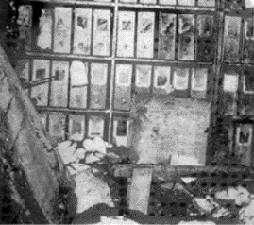IPUMS USA is now disseminating complete count data from 1850-1940, not including 1890. Hooray! But, but, but…you might ask…what happened to the 1890 Census?
We’re glad you asked.
The fate of the 1890 Census is both mysterious and frustrating. Although many sources report that millions of completed 1890 Census questionnaires burned in a fire, the story is far more complex. Also, empathize with IPUMS USA for a moment — imagine working for years digitizing millions of observations from complete count census data only to have a massive 1890-sized hole in the middle of the series.
Controversy surrounding the 1890 census begins decades before its near-complete destruction. Immediately following enumeration, businesspeople from the Twin Cities — perhaps experiencing the metropolitan equivalent of teenage angst — accused each other of fraudulently adding thousands of “phony names” to the census. The business community of Saint Paul filed at least nineteen indictments against Minneapolis. Not to be outdone, the business community of Minneapolis responded with reciprocal indictments against Saint Paul.
In March of 1896, before aggregated statistics could be published, the first tragedy struck. The special schedules for mortality, crime, pauperism and benevolence, special classes, and parts of the transportation and insurance schedules were damaged by a fire and subsequently destroyed by the Department of the Interior. The general population schedules, however, remained in “fairly good condition” as reported by a census clerk in 1903.
That all changed in the afternoon of January 10, 1921. At the time all original census records were stored in a file room in the basement of the Commerce Building in Washington, D.C. A building watchman noticed smoke, but saw no fire, around boiler pipes running into the storage room holding the original 1890 general population schedules. He quickly called for the fire department.
After arriving, and with a large crowd watching from the street, the fire department flooded the basement of the Commerce Building — including the room storing the original general population schedules.

The aftermath. Source: the National Archives
The next morning, wading through ankle-deep water, Census staff assessed the damage. Although census documents from years before and after 1890 were, for the most part, safely stored in a fireproof and waterproof vault in the basement, the 1890 documents were stacked outside of this vault. Estimates of the extent of the damage varied widely. Some claimed that only 25 percent were destroyed, and others seemed certain that all records were “absolutely ruined.”
The ultimate source of the incident in the basement of the Commerce Building was investigated, but a definitive cause was never determined. Theories range from suggesting the fire was started by a cigarette from a lackadaisical smoker, to spontaneous combustion, to wild conspiracies involving real estate fraud.
Later that month, the still-damp and singed remains of the original 1890 general population schedules were moved to a warehouse for temporary storage. The director of the Census at the time, Sam Rogers, recommended that the existing 1890 documents were unsalvageable and ought to be destroyed. Many protested this conclusion. In May of 1921, the remaining 1890 documents were brought to the census building for storage. On February 21, 1933, Congress authorized the destruction of the existing 1890 census schedules.

Source: the National Archives
Years later, in 1942, a damaged bundle of 1890 general population schedules from Illinois were delivered to the National Archives, reportedly found at the Census Bureau. Nine years later, more incomplete sets of the 1890 census showed up. Incomplete sets of schedules from Alabama, Georgia, Minnesota, New Jersey, New York, North Carolina, Ohio, South Dakota, Texas, and the District of Columbia joined the remaining schedules from Illinois as the surviving set of 1890 schedules. An estimated 6,000 records survived and are stored at the National Archives.
More details about the 1890 Census can be found in this article published by the National Archives.
Story by Jeffrey R. Bloem
Ph.D. Candidate, Applied Economics




